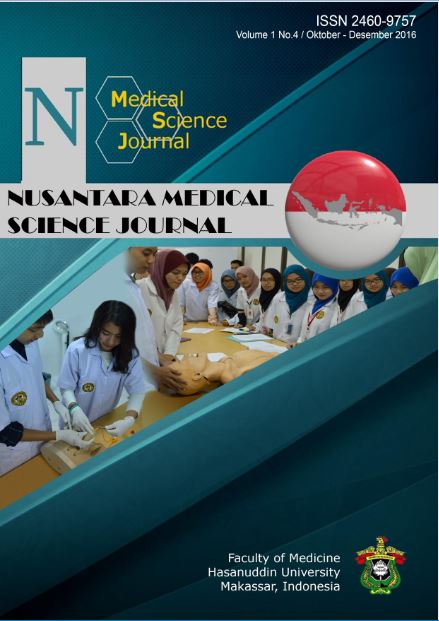DISTRIBUTION PATTERNS OF ANGIOGENESIS IN COLORECTAL CANCER: STUDY PROTEIN EXPRESSION OF ENDOGLIN (CD105)
Article History
Submited : August 9, 2017
Published : August 9, 2017
ABSTRACT Introduction: Angiogenesis plays an important role in the growth and metastasis of colorectal carcinoma, which is currently one of the targets of cancer therapy. It has been reported that the Endoglin (CD105) involved in angiogenesis and is a powerful marker for angiogenesis in colorectal carcinoma. Level Quantitative angiogenesis in peritumor and an intratumor area is important to know because it is closely related to the micro-environmental factors that influence the occurrence of cancer angiogenesis. The goal of this study to analyze the distribution pattern of angiogenesis in colorectal cancer by comparing the distribution of angiogenesis in peritumor and intratumor areas between well, moderate and poorly differentiated colorectal carcinoma, and between metastasis and non-metastatic colorectal cancer. Methods: This study analyzed fifty samples of resected adenocarcinoma colorectal. Angiogenesis was assessed by the immunohistochemical method using a primary monoclonal antibody Endoglin (CD105). Positive expression of CD105 was assessed through the CD105 protein expression in neovascular endothelial cells, while the distribution pat- tern of angiogenesis assessed by counting the positive expression of CD105 protein in hot spots by using the MVD (microvessel density) in the peritumor and intratumor areas and then performed statistical analysis. Results: There is a significant difference between the quantitative level of an- giogenesis in peritumor and intratumor areas of well (P<0.01), moderate (P<0.01) and poorly (<0.05) differentiated adenocarcinoma. The significant difference between the quantitative levels of angio- genesis in peritumor and intratumor areas of non-metastatic colorectal cancer (P<0.01) and lymph node metastases (<0.05) was found, but not in colorectal cancer with liver metastasis. Conclu- sion: Angiogenesis pattern is more concentrated in peritumor compared to intratumor areas. This showed the role of stromal cells in-angiogenesis. There is significant expression between angio- genesis in peritumor and intratumor areas. Keywords: Angiogenesis, Colorectal cancer, Endoglin (CD105)
References
- Weitz J, Koch M, Debus J, et al. Colorectal cancer. Lancet. 2005; 365 (9454):153-165.
- WHO. Colorectal cancer: Estimated incidence, mortality and prevalence worldwide in 2012. Globocan 2012. Available: http://globocan.
- iarc.fr/Pages/fact_sheets_cancer. aspx? cancer=colorectal
- Fearon ER, Vogelstein BA. genetic model for colorectal tumorigenesis. Cell. 1990; 61(5): 759–767.
- Symptom of colorectal cancer. colorectal cancer association of canada 2011. Available at: http//:www.colorectal-cancer.ca/en/just-thefacts/
- symptoms/.
- August DA, Ottow RT, Sugarbaker PH. Clinical perspective of human colorectal cancer metastasis. Cancer Metastasis Rev. 1984; 3(4):303-324.
- Folkman J. Tumor angiogenesis: therapeutic
- implication. N Engl J Med. 1971; 285: 1182-
- Folkman J. What is the evidence that tumor are angiogenesis dependent?. J Natl Cancer Inst. 1990; 82: 4-6
- GrotheyA, Allegra C. Antiangiogenesis therapy the treatment of metastatic colorectal cancer. Ther Adv Med Oncol. 2012; 4(6): 301-319.
- Arjaans M, Schröder CP, de Vries EG, et al. VEGF pathway targeting agents, vessel normalization and tumor drug uptake: from bench
- to bedside. Oncotarget. 2016; 7(16): 21247- 21258.
- Sandra FM, Rui MR, Antonio MR, et al. Role of endoglin and VEGF family expression in colorectal cancer prognosis and anti-angiogenic
- therapies. World J Clin Oncol. 2011; 10; 2(6): 272-280.
- Nassiri F, Cusimano MD, Lloyd RV, et al. Endoglin (CD105): a review of its role in angiogenesis and tumor diagnosis, progression
- and therapy. Anticancer Res. 2011; 31(6): 2283-2290.
- Minhajat R, Daisuke M, Tokunaga O, et al. Endoglin (CD105) expression in angiogenesis of colon cancer: analysis using tissue microarrays and comparison with other endothelial markers. Virchows Arch. 2006; 448(2):
- -34
- Minhajat R, Daisuke M, Tokunaga O, et al. Organ-specific endoglin (CD105) expression in the angiogenesis of human cancers. Pathol Int. 2006; 56(12): 717-23.
- Rosen LS, Gordon MS, Matei DE, et all. Endoglin for targeted cancer treatment. Curr Oncol Rep. 2014; 16(2): 365.
- Tonini T, Rossi F, Claudio PP. Oncogene. 2003; 29; 22(42): 6549-9556.
- Shieh YS, Lee HS, Shiah SG, at al. Role of angiogenic and non angiogenic mechanisms in oral squamous cell carcinoma: correlation
- with histologic differentiation and tumor progression. J Oral Pathol Med. 2004; 33(10): 601-6.
Minhajat, R., Benyamin, A. F., Harjianti, T., & Miskad, U. A. (2017). DISTRIBUTION PATTERNS OF ANGIOGENESIS IN COLORECTAL CANCER: STUDY PROTEIN EXPRESSION OF ENDOGLIN (CD105). Nusantara Medical Science Journal, 1(4), 127-132. https://doi.org/10.20956/nmsj.v1i4.2249
Downloads
Download data is not yet available.
Fulltext
